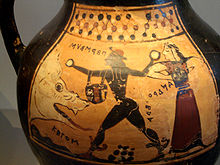
Back سيمونيدس Arabic Сіманід Byelorussian Симонид Bulgarian Simònides de Ceos Catalan Simónidés z Keu Czech Simonides Welsh Simonides von Keos German Σιμωνίδης ο Κείος Greek Simonido el Kea Esperanto Simónides de Ceos Spanish


Simonides of Ceos (/saɪˈmɒnɪˌdiːz/; Greek: Σιμωνίδης ὁ Κεῖος; c. 556 – 468 BC) was a Greek lyric poet, born in Ioulis on Ceos. The scholars of Hellenistic Alexandria included him in the canonical list of the nine lyric poets esteemed by them as worthy of critical study. Included on this list were Bacchylides, his nephew, and Pindar, reputedly a bitter rival, both of whom benefited from his innovative approach to lyric poetry. Simonides, however, was more involved than either in the major events and with the personalities of their times.[1]
Lessing, writing in the Enlightenment era, referred to him as "the Greek Voltaire."[2] His general renown owes much to traditional accounts of his colourful life, as one of the wisest of men; as a greedy miser; as an inventor of a system of mnemonics; and the inventor of some letters of the Greek alphabet (ω, η, ξ, ψ).[3] Such accounts include fanciful elements, yet he had a real influence on the sophistic enlightenment of the Classical era.[4] His fame as a poet rests largely on his ability to present basic human situations with affecting simplicity.[5] In the words of the Roman rhetorician Quintilian (35–100 AD):
Simonides has a simple style, but he can be commended for the aptness of his language and for a certain charm; his chief merit, however, lies in the power to excite pity, so much so that some prefer him in this respect to all other writers of the genre.[6]
He is popularly associated with epitaphs commemorating fallen warriors, as for example the Lacedaemonians at the Battle of Thermopylae:
Ὦ ξεῖν', ἀγγέλλειν Λακεδαιμονίοις ὅτι τῇδε |
Tell them in Lacedaemon, passer-by |
| —Translated by F. L. Lucas as an English heroic couplet |
Today only glimpses of his poetry remain, either in the form of papyrus fragments or quotations by ancient literary figures, yet new fragments continue to be unearthed by archaeologists at Oxyrhynchus, a city and archaeological site in Egypt that has yielded papyrus fragments from over a century of excavations. He is included in narratives as diverse as Mary Renault's modern historical novel The Praise Singer (where he is the narrator and main character), Plato's Protagoras (where he is a topic of conversation), and some verses in Callimachus' Aetia (where he is portrayed as a ghost complaining about the desecration of his own tomb in Acragas).[8]
- ^ John H. Molyneux, Simonides: A Historical Study, Bolchazy-Carducci Publishers (1992), page 3
- ^ G. E. Lessing (1836). Laocoon; Or The Limits of Poetry and Painting. J. Ridgway & Sons. pp. xvi – via Google books.
- ^ David A. Campbell, Greek Lyric Poetry, Bristol Classical Press (1982), pages 380-381
- ^ Charles Segal, Choral lyric in the fifth century, 'The Cambridge History of Classical Literature: Greek Literature' (1985), P. Easterling & B. Knox (eds), pages 223, 226
- ^ Cite error: The named reference
Charles Segal 1985 page 225was invoked but never defined (see the help page). - ^ Quintilian, Inst. 10.1.64, translated by David A. Campbell, Greek Lyric III, Loeb Classical Library (1991), page 359
- ^ Herodotus, Book VII, 228
- ^ Callimachus fr. 64. 1-14, cited by D. A. Campbell, Greek Lyric III, Loeb Classical Library, pages 344-6
© MMXXIII Rich X Search. We shall prevail. All rights reserved. Rich X Search